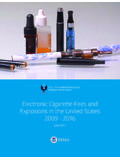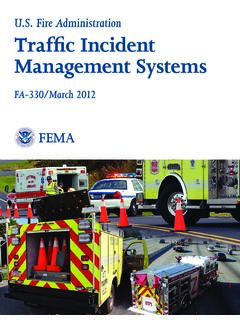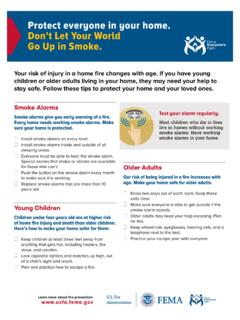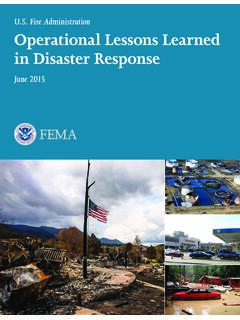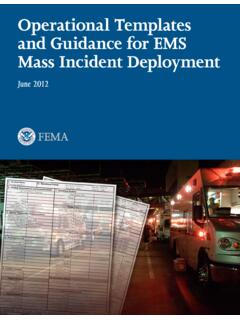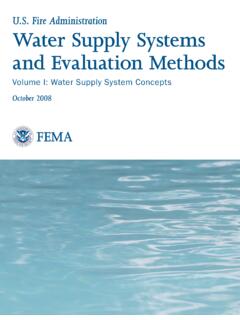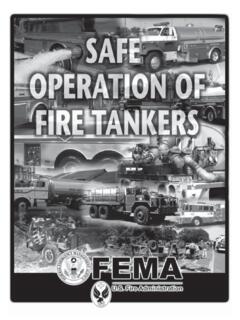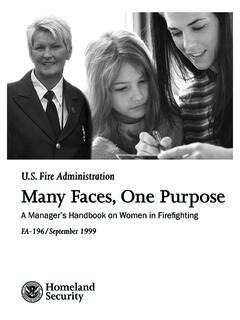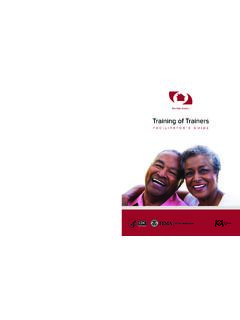Transcription of Emergency Vehicle Safety Initiative
1 Fire AdministrationEmergency Vehicle Safety InitiativeFA-336/February Fire AdministrationMission StatementWe provide national leadership to foster a solid foundation for our fi re and Emergency services stakeholders in prevention, preparedness, and response. iTable of ContentsTable of Contents ..iPreface ..viiChapter 1 Introduction ..1 Early Efforts to Address This Issue ..1 Safe Operation of Tankers ..2 Emergency Vehicle Safety Initiative ..2 Multiple Fire Service Association Projects ..3 Additional Research on Vehicle and Roadway Safety ..5 Traffic Incident Management Systems ..5 Technology and Incident Reporting Research ..5 Emergency Vehicle Visibility and Lighting Research ..6 Other Government Initiatives for Roadway Safety ..7 National Traffic Incident Management Coalition ..7 Federal Highway Administration Traffic Incident Management Website ..8 Federal Highway Administration Traffic Incident Management Handbook.
2 8 Manual on Uniform Traffic Control Devices ..8 About This Report ..11 Chapter 2 Statistics and Case Studies ..13 Introduction ..13 Limitations ..13 Fire Department Statistics ..13 Injuries Responding To and From an Alarm ..13 Cause and Location of Incidents Resulting in Injuries ..13 Firefighter Fatalities ..16 Law Enforcement Statistics ..17 Injuries and Cause ..17 Fatalities ..18 Emergency Medical Services Statistics ..19 Injuries ..20 Fatalities ..20 Case Studies ..21 Firefighter Fatalities ..21 Law Enforcement Officer Fatalities ..26 Chapter 3 Common Crash Causes and Their Prevention ..33 Intersections ..33 Emergency Vehicle Safety Initiative ii Excessive Speed ..35 Keeping the Vehicle s Wheels on the Road Surface ..37 Safely Negotiating Curves ..38 Passing Other Vehicles Safely ..39 Vehicle Unfamiliarity ..40 Driving in Inclement Weather ..42 Avoiding and Combating Skids ..44 Safe Vehicle Spacing ..45 Vehicle Backing Operations.
3 46 Driver Distractions ..47 Siren Syndrome ..48 Fatigue ..48 Seatbelt Usage ..49 Summary ..50 Chapter 4 The Impact of Vehicle Design and Maintenance on Safety ..53 Introduction ..53Ve h ic le D e s ig n ..53 Fire Apparatus ..53 Law Enforcement Vehicles ..53 Ambulances ..54 Restraints ..55 Loose Equipment Storage ..56 Emergency Vehicle Lighting ..58 Warning Light Colors ..58 Red Lights .. 58 Amber Lights ..59 Green of Warning Lights ..60 Rotating Flashing Lights ..61 Light-emitting Diode Lighting ..61 Other Types of Warning Lights ..62 Available Research on Emergency Vehicle Lighting ..63 iiiPhoenix Fire Department Study ..63 Loughborough University Study ..63 Flash Rate ..64 Light Color ..64 Hazards to Motorists ..64 Arizona Blue Ribbon Panel Study and Report ..65 Light Output ..65 Light Color ..65 Flash Rates ..65 Ramp Highway Patrol Study ..66 Light Color ..66 Flash Rate and Pattern ..66U .S . Fire Administration/Federal Emergency Management Agency Sponsored Research.
4 66 Conspicuity ..70 Retroreflectivity ..70 Factors Affecting Visibility and Recognition ..70 Contrast ..71 Fluorescent Colors ..71 Research Findings Related to Conspicuity ..71 Contour Markings ..71 Placement ..71 Fluorescent Colors ..72 Efficiency ..72 Standards Related to Emergency Vehicle Visibility and Conspicuity ..72 Fire Standards ..72 Law Enforcement Standards ..73 Emergency Medical Services Ambulance Standards ..73 Vehicle Inspection and Maintenance ..74 Routine Inspection and Maintenance ..74 Removing a Vehicle From Service ..74 Summary ..75 References ..75 Chapter 5 Improving Response-related Safety : Internal Factors ..77 Introduction ..77 Agency Vehicle Response Policies ..77 Standard Operating Procedures ..77 Prioritizing Dispatch ..77 Response Matrix ..78 Alternative Response Policies for Fire Departments ..78 Alternative Response Policies for Emergency Medical Services ..80 Alternative Response Policies for Law Enforcement Agencies.
5 80 iv Emergency Vehicle Safety InitiativeTraining ..82 Training Requirements ..82 Identifying the Need for Additional Training ..84 Training Program Components ..85 Available Training Programs and Resources ..86 Emergency Vehicle Occupant Safety ..86 Responsibilities of the Driver ..86 Safety Usage in Fire of the Company/Lead Officer ..87 Responsibilities of the Passenger ..88 Department/Agency Responsibilities ..89 Personal Responsibilities ..90 Summary ..91 Chapter 6 Improving Response-related Safety : External Factors ..93 Introduction ..93 DOT Intelligent Transportation Systems Program ..93 Traffic Surveillance Technology ..94 Mayday and Automatic Collision Notification Systems ..94 Intelligent Vehicles ..95 Freeway Service Patrols ..95 Next Generation 9-1-1 ..95 Dynamic (Changeable) Message Signs ..97 Traffic Signal Pre-emption Systems ..98 Implementation ..98 Vehicular Device Types ..99 Acoustic ..99 Line-of-sight.
6 99 Global Positioning System ..100 Localized Radio Signal ..100 Traffic Management Centers ..101 Closed Circuit Television Camera Surveillance ..101 Roadway Weather Information Lane Message Signs ..101 Safe Operation of Privately Owned ..104 Chapter 7 Regulating Emergency Vehicle Response and Roadway Scene Safety . 105 Introduction ..105 National Fire Protection Association Standards ..105 NFPA 1002, Standard for Fire Apparatus Driver/Operator Professional vNFPA 1091, Standard for Traffic Control Incident Management Professional Qualifications ..106 NFPA 1451, Standard for a Fire and Emergency Services Vehicle Operations Training Program ..107 NFPA 1500, Standard on Fire Department Occupational Safety and Health Program ..109 NFPA 1917, Standard for Automotive Ambulances ..112 DOT Manual on Uniform Traffic Control Devices ..112 Temporary Traffic Control Zones ..112 Advanced Warning n sition A Area ..114 Channelizing Devices.
7 114 Signs ..116 Directional Arrow Boards ..117 Barricades ..119 Flagger Control ..120 Hand-signaling Location ..121 Audible Warning Visibility Safety Apparel ..122 American National Standards Institute/International Safety Equipment Association National Standards Institute/International Safety Equipment Association ..126 Chapter 8 Roadway Incident Scene Safety ..127 Introduction ..127 Agencies That Respond to Roadway Incidents and Their Responsibilities ..127 Law Enforcement Agencies ..127 Fire and Rescue Agencies ..128 Emergency Medical Services ..129 Transportation Agencies ..129 Towing and Recovery Services ..130 Emergency Management Agency ..130 Coroners and Medical Examiners ..130 Hazardous Materials Clean-up Firms ..130 Animal Medical Response Services ..131 News Media ..131 Understanding and Respecting Each Other s Roles ..131 Managing Roadway Incident Scenes ..134 Size-up and Assuming Command ..134 Rules of Priorities.
8 137 Basic Incident Command System Structure ..138 vi Emergency Vehicle Safety InitiativeResponse ..138 Levels of Command ..139 Expanding the Up a Safe Work Zone at Roadway Incidents ..142 Emergency Vehicle Placement ..143 Effective Use of Warning Lights on the Roadway Emergency Scene ..145 Proper Protective Clothing for Personnel Operating at Roadway Incidents ..146 Summary ..147 Chapter 9 Summary and Recommendations ..149 Appendix Resource Websites and Information Sources ..151 Acronym List ..157 viiPrefaceThis project was supported by Interagency Agreement No . 2009-DE-R-103 and award-ed by the National Institute of Justice (NIJ), Office of Justice Programs (OJP), U .S . Department of Justice (DOJ) to the U .S . Fire Administration (USFA) . The opinions, findings, and conclusions or recommendations expressed in this publication/program/exhibition are those of the author(s) and do not necessarily reflect those of the DOJ .The USFA made a cooperative research agreement with the International Fire Ser-vice Training Association (IFSTA) at Oklahoma State University (OSU) to develop this report.
9 IFSTA and its partner, OSU Fire Protection Publications, have been a major publisher of fire service training materials since 1934 . Through its association with the OSU College of Engineering, Architecture, and Technology, it also conducts a variety of funded, technical research on fire service, fire prevention and life Safety issues . Special thanks are due to USFA Fire Program Specialist William Troup for his particular efforts toward improving Emergency responder Safety related to Emergency Vehicle response and roadway Safety .The extensive information provided within this report would not have been possible without the dedication and efforts of the following people assigned to this project:Nancy Trench Project AdministratorMichael A . Wieder Principle Investigator/Project ManagerJudy Janing Principle WriterClint Parker Senior Graphics TechnicianCheryl Robinson Project Research SpecialistThe USFA and IFSTA would also like to thank the following individuals who reviewed and commented on the draft version of this report:Steve Austin, Cumberland Valley Volunteer Firemen s AssociationSharon Baroncelli, International Association of Fire ChiefsBrian Montgomery, Officer Safety and Protective Technologies Program Manager, U.
10 S . Department of Justice, National Institute of JusticeLarry McKenna, U .S . Fire Administration Fire Program SpecialistEmergency Vehicle Safety Initiative viii Introduction 1 Chapter 1 IntroductionIf you polled the public and asked people during which portion of a firefighter s job would that firefighter have the greatest chance of being killed, most would likely re-spond that this would be when firefighters are actually fighting a fire . Incidents in which firefighters are severely injured or killed while conducting tactical operations tend to draw more attention and news coverage . The truth is that firefighters are more likely to die in a motor Vehicle -related incident than during the course of a firefighting operation .The same situation is true for law enforcement officers . Most people would likely assume that gunshots are the most common cause of fatal injuries to law enforcement officers . However, at the time of this report, Vehicle -related fatalities were the leading cause of death to law enforcement officers in the United States for 11 of the 12 previous years.
